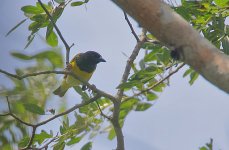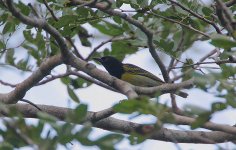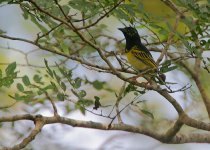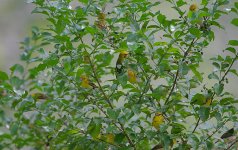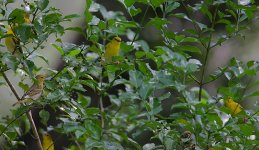Steve G
RAINBIRDER
Clarke's Weaver (Ploceus golandi) images taken in Arabuko-Sokoke forest in Kenya thanks to the great birding skills of David Ngala.
This enigmatic wee forest weaver is a Kenyan endemic which is only found in the Arabuko-Sokoke Forest & in some patches of Brachystegia forest to the north & west at Galana Ranch & Dakatcha Forest. The population was estimated to be not more than 1,000-2,000 pairs in the early 1980s and there has been no more recent assessment. The species may not breed in Arabuko-Sokoke Forest, since it appears to be largely absent during April-July, reappearing with young in August and thence regularly seen into November, with few records from December-February. It is believed to have bred north of the Sabaki river in 1994, when juveniles were observed near Dakatcha in mid-July. The exact breeding location & the breeding biology of this bird remains a mystery & no definite nests have yet been found.
In the Sokoke forest Clarke's Weaver is most frequent in the white-sand soil stands of mature Brachystegia forest where it can be found in noisy feeding flocks of 5-30 birds. It is most often found in association with other species in mixed-species feeding flocks. Indeed according to David Ngala the best way to locate Clarke's Weaver is to find such a feeding flock & follow it.
I watched David in action. He tunes in to the calls of certain species -particularly Drongos, which he describes as the 'soldiers' (robust, bold & noisy with a tendency to scold predators). Find such a 'soldier' & other birds, especially Retz's & Chestnut-fronted Helmet-Shrikes also become apparent. Various other species tend to move in these groups including Scimitarbills, Thick-billed Cuckoo, Monarch Flycatchers, Honeyguides, Dark-backed Weavers (Ploceus bicolor) & of course Clarke's Weaver.
According to the limited data available Clarke's Weaver is said to feed high up in the canopy on beetles and caterpillars (IUCN & Birdlife fact-sheets). This was not our experience however. We found feeding groups of Clarke's Weaver in the canopy, subcanopy & in low shrubs where they were quite clearly seen to be taking small fruits & berries. Indeed the scene reminded me of that typical of a feeding group of neo-tropical Tanagers.
The enclosed images are of adult males, a moulting male and a feeding flock which includes females, juveniles and some birds with black flecking which are probably immature males.
You can follow David Ngala's conservation work in the Arabuko-Sokoke forest on his blog. Consider donating to support his work in conserving this wonderful place. David's blog is here: http://davidngala.wildlifedirect.org/
Cheers,
Steve
This enigmatic wee forest weaver is a Kenyan endemic which is only found in the Arabuko-Sokoke Forest & in some patches of Brachystegia forest to the north & west at Galana Ranch & Dakatcha Forest. The population was estimated to be not more than 1,000-2,000 pairs in the early 1980s and there has been no more recent assessment. The species may not breed in Arabuko-Sokoke Forest, since it appears to be largely absent during April-July, reappearing with young in August and thence regularly seen into November, with few records from December-February. It is believed to have bred north of the Sabaki river in 1994, when juveniles were observed near Dakatcha in mid-July. The exact breeding location & the breeding biology of this bird remains a mystery & no definite nests have yet been found.
In the Sokoke forest Clarke's Weaver is most frequent in the white-sand soil stands of mature Brachystegia forest where it can be found in noisy feeding flocks of 5-30 birds. It is most often found in association with other species in mixed-species feeding flocks. Indeed according to David Ngala the best way to locate Clarke's Weaver is to find such a feeding flock & follow it.
I watched David in action. He tunes in to the calls of certain species -particularly Drongos, which he describes as the 'soldiers' (robust, bold & noisy with a tendency to scold predators). Find such a 'soldier' & other birds, especially Retz's & Chestnut-fronted Helmet-Shrikes also become apparent. Various other species tend to move in these groups including Scimitarbills, Thick-billed Cuckoo, Monarch Flycatchers, Honeyguides, Dark-backed Weavers (Ploceus bicolor) & of course Clarke's Weaver.
According to the limited data available Clarke's Weaver is said to feed high up in the canopy on beetles and caterpillars (IUCN & Birdlife fact-sheets). This was not our experience however. We found feeding groups of Clarke's Weaver in the canopy, subcanopy & in low shrubs where they were quite clearly seen to be taking small fruits & berries. Indeed the scene reminded me of that typical of a feeding group of neo-tropical Tanagers.
The enclosed images are of adult males, a moulting male and a feeding flock which includes females, juveniles and some birds with black flecking which are probably immature males.
You can follow David Ngala's conservation work in the Arabuko-Sokoke forest on his blog. Consider donating to support his work in conserving this wonderful place. David's blog is here: http://davidngala.wildlifedirect.org/
Cheers,
Steve




